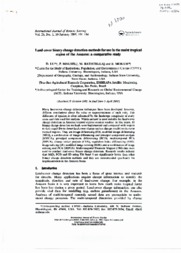Land-cover binary change detection methods for use in the moist tropical region of the Amazon: a comparative study.
Land-cover binary change detection methods for use in the moist tropical region of the Amazon: a comparative study.
Author(s): LU, D.; MAUSEL, P.; BATISTELLA, M.; MORAN, E.
Summary: Many land-cover change detection techniques have been developed; however, different conclusions about the value or appropriateness of each exist. This difference of opinion is often influenced by the landscape complexity of study areas and data used for analysis. Which method is most suitable for land-cover change detection in Amazon tropical regions remains unclear. ln this paper, 10 binary change detection methods were implemented and compared with respect to their capability to detect land-cover change and no change conditions in moist tropical regions. They are image differencing (ID), modified image differencing (MID), a combination of image differencing and principal component analysis (IDPCA), principal component differencing (PCD), multitemporal PCA (MPCA), change vector analysis (CVA), vegetation index differencing (VID), image ratioing (IR), modified image ratioing (MIR), and a combination of image ratioing and PCA (lRPCA). Multi-temporal Thematic Mapper (TM) data were used to conduct land-cover binary change detection. Research results indicate that MID, PCD and ID using TM band 5 are significant1y better than other binary change detection methods and they are recommended specifically for implementation in the Amazon basin.
Publication year: 2005
Types of publication: Journal article
Unit: Embrapa Territorial
Keywords: Amazonas, Monitoramento, Região Amazônica, Satélite, Vegetação
Observation
Some of Embrapa's publications are published as ePub files. To read them, use or download one of the following free software options to your computer or mobile device. Android: Google Play Books; IOS: iBooks; Windows and Linux: Calibre.
Access other publications
Access the Agricultural Research Database (BDPA) to consult Embrapa's full library collection and records.
Visit Embrapa Bookstore to purchase books and other publications sold by Embrapa.

